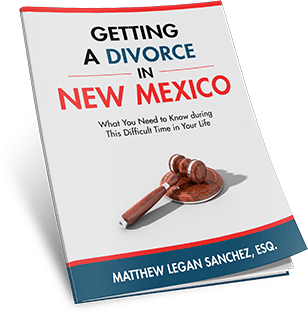Sad but true, domestic abuse often plays a prominent role in child legal custody and contested and uncontested divorce cases. In some cases, the pain of divorce or marital separation reaches a boiling point and erupts into family violence.
In New Mexico, abuse among household members falls under the Family Violence Protection Act. Specifically, a handful of abusive acts can lead to a restraining order of protection being entered.
Contrary to common belief, abuse is not limited to physical or domestic violence. Instead, abusive acts also include:
- Severe emotional distress;
- Criminal trespass;
- Criminal damage to property;
- Repeatedly driving by a residence or workplace;
- Telephone harassment;
- Harassment; or
- Physical acts of domestic violence.
Let’s examine an average day in the life of a restraining order of protection lawyer. By doing so, readers will achieve a better understanding about the restraining order process.
WHAT TO EXPECT AT A RESTRAINING ORDER OF PROTECTION HEARING?
The process begins when an alleged victim files a Petition for Order of Protection. The petition/request is filed in the county where the alleged victim lives. A Temporary Restraining Order (TRO) is entered when the Petition provides sufficient evidence that an act of abuse occurred.
When a Temporary Restraining Order is entered, a hearing usually is held within ten days. At this hearing, a Special Commissioner/Hearing Officer hears both sides of the story. After all evidence and testimony is presented, the Hearing Officer determines if a “permanent” Protection order is entered.
The word “permanent” is a bit misleading. You see, a “permanent” Protection order usually only lasts for one year.
Now that we have a better understanding of the overall process, let’s examine a typical day in the life of a restraining order of protection lawyer.
8:00 AM: TRAVEL TO COURT
Restraining Orders are filed in the county where the alleged victim lives. Therefore, an alleged victim that lives in Albuquerque files the necessary petition with Second Judicial District Court in Bernalillo County. Alternatively, an alleged victim that lives in Rio Rancho files with Thirteenth Judicial District Court in Sandoval County.
On this day, the restraining order hearing was held in Thirteenth Judicial District Courthouse in Sandoval County. Currently, Thirteenth Judicial is holding in-person hearings. On the other hand, Second Judicial is holding most hearings by either Zoom, Google Meet, or telephone.
My office is in downtown Albuquerque. As I type these words, Second Judicial Court is peaking through my office window.
The day that I am outlining began with traveling to Rio Rancho at around 8:00 AM.
Typically, it takes about 30 minutes to get to Thirteenth Judicial District Courthouse from Albuquerque.
8:30 AM: MEET AND CONFER
Both sides are required to “meet and confer” before the scheduled restraining order hearing. The purpose of meet and confer is to see if the parties can reach a mutual agreement. For instance, possibly the parties can agree to:
- Enter a stipulated (mutually agreed) order of protection;
- Enter a no contact order in a corresponding DM case; or
- Dismiss the Order of Protection.
On this day being discussed, I was representing the alleged victim. After meeting with the opposing party (i.e. Respondent), we were unable to reach any agreements. As such, we alerted the bailiff (Hearing Officer’s assistant) that no agreements could be reached, and a restraining order hearing was necessary.
9:00 AM: RESTRAINING ORDER HEARING BEGINS
Unfortunately, there isn’t a universal format for how restraining order hearings unfold. Sometimes the Hearing Officer will have the Petitioner/alleged victim present their case first. At other times, the Restraining Order Hearing Officer will have both sides give a brief Opening Statement, or summary of the claims/defenses. The flow depends on the Hearing Officer’s personality, preference, and docket load.
On this day, the assigned Restraining Order Hearing Officer began the hearing by asking each party for a summary of the case. After each summary, the Hearing Officer allowed the Petitioner/me to present our case.
To begin, I gave the court a summary of what the evidence what prove: severe emotional distress that demonstrates an immediate threat of future harm. I outlined the evidence that would be presented and how that evidence supports severe emotional distress, and the need for an Order of Protection.
Moving forward, I called the Petitioner as my first witness. In doing so, the Petitioner discussed recent and escalating abuse that occurred during the relationship. To support these statements, text messages and pictures were introduced into evidence.
Next, a witness testified about their personal observations of Respondent’s abuse. This testimony supported the Petitioner’s claims of emotional distress.
The Restraining Order Hearing Officer then asked if any other witnesses would be called. “No,” I responded. The Hearing Officer then enabled the Respondent to present their case.
10:00 AM: RESPONDENT’S CASE
The Respondent’s case was limited. No evidence was successfully introduced. Instead, the Respondent’s case was primarily based on personal testimony. In doing so, the Respondent attempted to talk away the claims of abuse.
Also, Respondent called his father as a witness. Father’s personal observations were limited. Any attempts to introduce hearsay (out of court statements by other people) were quickly objected to and sustained. In other words, Father’s testimony was limited. Most importantly, Father’s testimony marginally helped Respondent’s case – if at all.
The Restraining Order Hearing Officer then asked if Respondent had any other witnesses or evidence. “No,” Respondent replied. Accordingly, the Restraining Order Hearing Officer asked each side for brief closing statements.
11:00 AM: CLOSING ARGUMENT AND DECISION
Each side had an opportunity to briefly summarize their case. As Petitioner’s counsel, I presented first. In doing so, I summarized the witness testimony and evidence. I then discussed New Mexico law and how the Family Violence Protection Act enables an Order of Protection to be entered based on severe emotional distress.
Next, I discussed the legal burden: preponderance of the evidence. This “burden” basically means that the Petitioner bears the responsibility for proving that it is more likely than not that:
- An act of abuse occurred; and
- Respondent poses an immediate threat of future harm.
Ultimately, the Hearing Officer ruled that Petitioner’s burden was met. Accordingly, a one-year Order of Protection was entered against the Respondent.
11:30: PICK UP ORDER OF PROTECTION
When an Order of Protection is entered, it usually takes about 30 minutes for the Order to completed, signed, and filed. Once completed, the Order can be picked up with the DV clerk.
On this day, the 30-minute wait provided a chance for my client and myself to speak about the hearing. We then retrieved the Order and left the courthouse.
NOON: TRAVEL TO OFFICE
For the day, the Protection order process was complete. With that said, my day was just getting warmed up. After returning to my office, I had a quick lunch, and then dove into the next case.
5 TIPS FOR YOUR ORDER OF PROTECTION HEARING
- Show up on time.
- Provide witness and exhibit list 48 hours before your hearing.
- Come prepared. Even if you don’t retain a protection order lawyer, at a minimum, you should speak with the best restraining order lawyer about what to expect.
- Your appearance, body language, and tone of voice matter. In close cases, your appearance and demeanor (i.e. credibility) can make the difference between an Order being either granted, or denied.
- Follow your Order. Orders are not suggestions. Failing to follow your Order will result in criminal charges being filed.
CLOSING THOUGHTS ABOUT RESTRAINING ORDER OF PROTECTIONS
Although this blog is called, A Day in the Life, the described hearing only lasted a few hours. Even so, most restraining order of protection hearings are only set for 30 minutes to one hour. It’s also important to note that your Hearing Officer has wide discretion (big power) to decide if an Order will be entered.
In other words, treat your Hearing Officer with respect. In doing so, be aware that your body language and tone of voice are being monitored. Accordingly, angry, or aggressive behavior can tip the scale towards the protection Order being entered.
Finally, you have the right to represent yourself at the order of protection hearing. With that said, at a minimum, you should speak with the best order of protection attorney before your hearing. Specifically, you should speak with the best restraining order attorney about:
- The facts;
- Evidence;
- Assigned Hearing Officer;
- Likelihood that an Order will be entered; and
- Impact of an Order being entered.
Blindly walking into an Order of Protection hearing can be like walking the plank. In other words, you may be walking towards a dangerous fall. For instance, the fall may carry long term, negative consequences. Therefore, take the Order of Protection process seriously. You may seriously regret failing to give the process the necessary time, attention, and consideration that it deserves.
RESTRAINING ORDER OF PROTECTION ATTORNEY OR LAWYER IN NEW MEXICO
Do you have questions about a restraining order of protection in New Mexico? If so, Matthew Legan Sanchez has handled restraining orders for over a decade. During this time, Sanchez has handled domestic violence and restraining orders all across New Mexico, including Raton, Estancia, Santa Fe, Los Lunas/Belen, Rio Rancho, and Albuquerque. Call (505) SANCHEZ today.

Day in the Life of a Restraining Order of Protection Attorney









